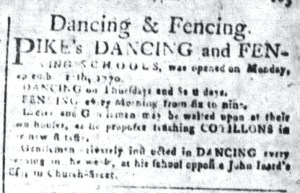What was advertised in a colonial American newspaper 250 years ago today?

“He proposes teaching COTILLONS in the newest taste.”
The South Carolina Newspapers collection available via Accessible Archives is an invaluable resource for producing the Adverts 250 Project and the Slavery Adverts 250 Project. The collection includes digitized images of three newspapers published in Charleston in 1770, the South-Carolina Gazette, the South-Carolina Gazette and Country Journal, and the South-Carolina and American General Gazette.
Transcriptions of the newspapers accompany the images. In many cases, those transcriptions make it easier to decipher the contents of advertisements and other items that appear illegible for a variety or reasons. Perhaps the original printing did not produce a clear impression in 1770 or the document suffered damage over time or poor photography resulted in a remediation that does not accurately the original. Sometimes more than one of these factors influence the quality of digital surrogates.
Transcriptions, whether undertaken by people or technology, must be consulted with care. Consider an advertisement for “PIKE’s DANCING and FENCING SCHOOLS” that ran in the October 3, 1770, edition of the South-Carolina and American General Gazette. The digital image is not easily legible, though an experienced research familiar with the language and contents of eighteenth-century newspaper advertisements can piece together the contents. The transcription, on the other hand, leaves out words, such as “Ladies” in the phrase “Ladies and Gentlemen,” and does not accurately reproduce others, such as “he proposes trashing COTILLONSisa new first” for “he proposes teaching COTILLONS in the newest taste.”

While this is obviously an error in the transcription, the interface created by Accessible Archives does correct an error that the compositor made when setting the type for the issue that contained Pike’s advertisement. That issue consisted of six pages, four pages created by printing two on each side of a broadsheet and folding it in half and two additional pages of advertising printed on either side of a smaller sheet. That supplement has the wrong date at the top, “Sept. 24 – Oct. 2” instead of “Sept. 24 – Oct. 3” at the top of the pages for the rest of the issue. The page numbers for the supplement, 183 and 184, run continuously with the pages printed on the larger sheet. The date 1770 appears in the title (an abbreviated masthead): “THE SOUTH-CAROLINA AND AMERICAN GENERAL GAZETTE, for 1770.” Dates in some of the advertisements also make it clear that the supplement was printed in 1770.
Yet manuscript additions indicate that at some time the supplement was separated from the rest of the issue. The first page includes a notation, either incomplete or partially illegible, that states, “Sup in 177[x],” with a missing digit at the end of the year. Similarly, the supplement has a notation, not entirely legible, that declares it “does not belong in this [state].” Most likely the “Oct. 2” error resulted in the supplement being cataloged or even bound with another issue of the South-Carolina and American General Gazette from another year, but an archivist noted the other discrepancies and context clues. In the end, Accessible Archives arranged the digital images of all six pages of the issue together and in the correct order, despite an error made by the compositor in 1770.

Human error and technological error sometimes creep into sources at every stage of their production, preservation, and remediation. Such errors introduce miniature mysteries that can be entertaining to solve, but they also challenge researchers to constantly assess their sources to recognize any features that seem out of place or inconsistent with what they know about the period they are investigating or the subsequent collection and treatment of primary sources that make them accessible.
